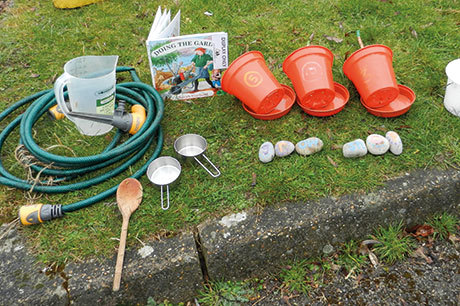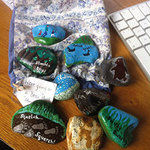
A quick glance through your setting’s library will highlight how many picture book stories take place outdoors. Many years ago, I was inspired by the way early years consultant Marjorie Ouvry used stories and storytelling to illustrate the connection between movement and cognition. Watching her explore stories outdoors, with children and practitioners, developed my appreciation of how outdoor spaces can bring stories alive.
These are just a few possibilities – almost any book can be used to stimulate imaginative and physical play outdoors.
1: DRAMA STORIES
Acting out stories and taking on character roles helps children develop language and early comprehension skills. Tales that lend themselves to active ‘promenading theatre’ include The Lighthouse Keeper’s Lunch, The Gruffalo, Stick Man and the Hairy Maclary series. Use the dressing-up box, and collect props from the outdoor play loose parts collections. Discuss locations; cut up a spare copy of the book, laminate the pages and place them in the stage set locations outdoors to remind children of what’s happening.
2: DANCE AND MOVEMENT STORIES
Outdoors is the place for big, flowing, chaotic and extravagant movements. Giraffes Can’t Dance is wonderful story for encouraging this – poor Gerald, with his knock-knees and gangly legs! Choose a few ‘different songs’ – pieces of funky music – and ask the children to invent new dance moves that incorporate the features and fixtures of the garden. Try out the different styles of dance that the other animals use – Latin, a reel, rock ’n’ roll. Where the Wild Things Are is an equally good choice.
3: COSY STORIES
Encourage a love of books with a cosy outdoor story space. Book corners have been popping up in early years gardens all over the country, and range from simple arrangements of cushions and deckchairs in the shade through to mini-beach huts and dedicated outdoor libraries. Choose children’s favourite books and buy multiple copies from charity shops, jumble sales and via donations; this way, you’ll be less worried about damage and children will feel freer to take the stories wherever they need to.
4: PHYSICALITY STORIES

Handa’s Surprise is a super story for physicality: it boosts balance, agility, perseverance and collaboration. Source a really big, flat basket (I found one at my local tip) and see who can carry objects the furthest or for the longest time. Don’t use real fruit – it will get bruised – but if you have wooden, dough or plastic fruits, they work well. Otherwise improvise: large pine cones for pineapples, conkers for passion fruit and so on. Make animal masks to enrich the storytelling, and try counting, sorting and grouping games. Or gather props for activities based on a book such as Doing the Garden.
5: STORY STONES
 Smooth, round pebbles make super story stones. Choose pebbles that have a decent weight to them and will fit snugly into children’s palms. A story with clear progression works best on story stones – for example, We’re Going On A Bear Hunt. Scenes from the story can be painted onto the stones with acrylic paint, Deco-pens or permanent markers and protected with varnish or PVA glue. Alternatively, scan illustrations from the book as jpegs, reduce them in size and print off in colour. Glue them to the stones and, again, varnish for protection. Use your story stones to help children sequence the story, recall the vocabulary and add their own twists to the tale.
Smooth, round pebbles make super story stones. Choose pebbles that have a decent weight to them and will fit snugly into children’s palms. A story with clear progression works best on story stones – for example, We’re Going On A Bear Hunt. Scenes from the story can be painted onto the stones with acrylic paint, Deco-pens or permanent markers and protected with varnish or PVA glue. Alternatively, scan illustrations from the book as jpegs, reduce them in size and print off in colour. Glue them to the stones and, again, varnish for protection. Use your story stones to help children sequence the story, recall the vocabulary and add their own twists to the tale.
BENEFIT-RISK ASSESSMENT
- Apply commonsense measures to ensure everyone stays safe when enjoying stories outdoors. Be realistic about the risks, thinking about the likelihood as well as the severity of accidents. Good health and safety practice is there to enable risky, exciting play, not prevent it.
- Find a shady spot for your cosy story corner if children are likely to sit reading for any length of time.
- Assess your space for hazards that may not be apparent in ‘normal’ play. For example, will children want to dance over the balance beam? Attach a pulley to the climbing frame to carry the lunch basket to the lighthouse?
- Story stones are no more likely to be thrown than any other similar object. However, you could minimise that likelihood by reminding children that they are magical story stones and not missiles, and keeping them in a story sack along with a few props and a laminated copy of the story they illustrate.









